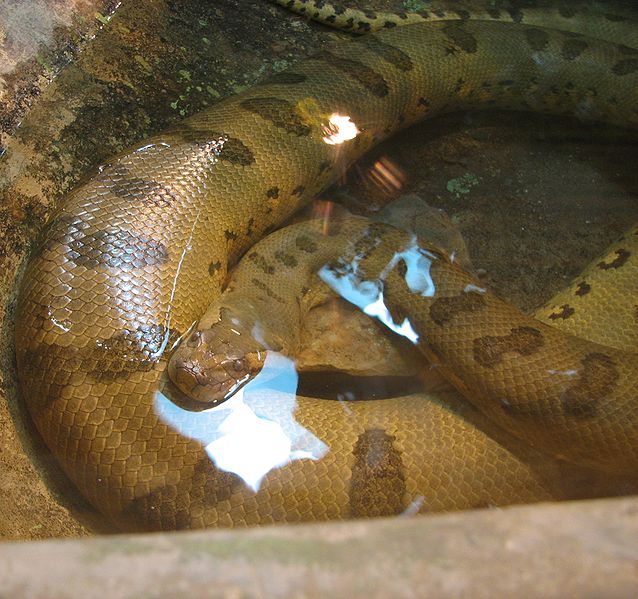 Working with Green Anacondas (Eunectes murinus) in the Bronx Zoo and participating in a capture/tagging project in Venezuela was a childhood dream come true. While I cannot recommend a potentially deadly behemoth as a pet, interest in them is always high…today I’ll highlight the natural history of this impressive giant.
Working with Green Anacondas (Eunectes murinus) in the Bronx Zoo and participating in a capture/tagging project in Venezuela was a childhood dream come true. While I cannot recommend a potentially deadly behemoth as a pet, interest in them is always high…today I’ll highlight the natural history of this impressive giant.
Description
A stout animal that may exceed 400 pounds in weight, this is the world’s heaviest snake. It vies with the Reticulated Python for the title of longest serpent.
In the past, 25-foot-long animals were encountered, but an individual approaching 20 feet is considered large today. There is a fairly reliable record of a 33-foot-long Green Anaconda; an unverified field report from Eastern Columbia (1944) claims an individual of 37.5 feet. In the course of tagging over 500 specimens, the largest I and my co-workers encountered in Western Venezuela was just over 17 feet long and tipped the scale at 215 pounds.
Wild males rarely exceed 12 feet in length, and are thinly built. A captive male under my care was, however, as heavily built as any female and measured in excess of 15 feet; colleagues report similar experiences.
The dorsal surface is dark green, olive or grayish-green and marked with irregular black blotches. The ventral surface is yellow with black blotches. The eyes and nostrils are dorsally located, an adaptation to the largely aquatic lifestyle.
Range
Trinidad and much of tropical South America east of the Andes – Venezuela, Columbia, Brazil, Northern Bolivia, Northeastern Peru, Guyana and French Guiana.
Habitat
Green Anacondas are almost completely aquatic and rarely stray far from water. They inhabit rivers, swamps, lakes and flooded grasslands.
Status
 Status is difficult to ascertain due to the nature of the habitat, but declines have been documented; listed on CITES Appendix II.
Status is difficult to ascertain due to the nature of the habitat, but declines have been documented; listed on CITES Appendix II.
Feared and often killed when encountered, Green Anacondas are hunted in some areas for their skin and fat (believed to be of medicinal value). They are also threatened by the expansion of farms and ranches.
Longevity
Captives have lived in excess of 31 years; unknown in the wild
Reproduction
Several males (2-12) coil about a single female, drawn by the pheromones she releases. Spurs alongside the cloaca are rubbed against the female to help elicit copulation. Successful males may introduce a waxy plug into the cloaca in an attempt to assure paternity.
Green Anacondas give birth to 10-100 live young after a gestation period of approximately 6 months. The size and number of young are related to the size and health of the mother. Examples from animals under my care: a 20-foot-long female gave birth to 50 young averaging 3 feet in length; a 13-footer produced a dozen youngsters averaging 24 inches.
Gravid females bask far more frequently than do others, and may consume the fetal membrane and infertile eggs passed with the young. Newborn Green Anacondas are secretive and rarely seen; little is known of their natural history.
Further Reading
You can read more about the research mentioned above in these articles:
Hunting Anacondas in the Venezuelan Llanos
Anaconda Expert Wades Barefoot in Venezuela’s Swamps
National Geographic Video of an Anaconda capturing a Capybara.
 That Reptile Blog – Reptile, Amphibian and Exotic Pet Care and Information
That Reptile Blog – Reptile, Amphibian and Exotic Pet Care and Information



I am really interested to hear your thoughts on the recent ban on large snakes in Florida. Personally, I think we as a community brought this upon ourselves by selling large snakes to irresponsible keepers who then released the unwanted pet into the wild. But then again we cannot investigate each and every buyer and there will never be a guarantee with any buyer so its almost a catch 22 situation how can we remedy this from going further?
Hello John, Frank Indiviglio here.
Thanks for your interest in our blog. Important point, thanks. I’ve been involved in many investigations into serious injuries and fatalities…in my opinion giant constrictors, venomous snakes, crocodilians etc. are not appropriate animals to be selling in the trade for private collections. The problem re introductions can happen with countless species, especially in Florida, but in this case we have a serious safety issue as well.
Good luck and please keep me posted.
Best regards, Frank Indiviglio.
I love that pic of the snake.
Hello Breonna, Frank Indiviglio here.
Thanks for your interest in our blog…I was very fortunate to have been there. Look forward to hearing from you in the future.
Please let me know if you need any further information. Good luck, enjoy and please keep me posted.
Best regards, Frank Indiviglio.